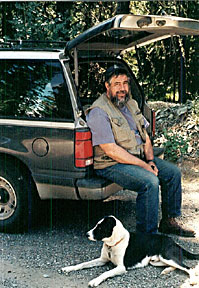|
COVER STORY | IN
THE NEWS | ARTBEAT August 3, 2006
My first memory of Tim was in 1967, the Summer of Love, when I passed through Arcata as a teenager. There weren't too many environmentalists, progressives or even Democrats in Arcata in those days. Even the students at Humboldt State College back then were mostly conservative. The "hippies" lived in a big house by the old stoplight at 17th Street and Highway 101. It was where I met Tim McKay, John Woolley and other friends who I still know today. Even then they were cooking up ways to get young people involved in the political process to try and make the world a better place. In 1972 I remember going to a little office on the first floor of the Arcata Hotel to sign up for the children's crusade to remove Richard Nixon from office with an anti-Vietnam War candidate named Sen. George McGovern. There was Tim helping to coordinate our grassroots effort. While we lost that election in a nationwide landslide and we only got rid of Nixon through impeachment, lessons learned locally helped us the following year to defeat the proposed Butler Valley Dam at the ballot box, and win many elections to come. The friendships born at the house later spawned the softball team that came to be known as the Northcoast Environmental Center Snail Darters. Tim named the team after that indomitable little fish that stopped a dam in Tennessee. I was present at the birth of the Northcoast Environmental Center as the first executive director, but in its early stages it could best be described as having great, unfulfilled potential. It was only under Tim's 35 years of leadership that NEC became what it is today — a nationally recognized and locally vital resource that has constantly brought us back to seeing activism for protecting the environment through the prism of good information and good science. — Sen. Wes Chesbro
I arrived in Arcata in the spring of 1973 to attend Humboldt State College. As I walked down from the college toward town that first evening, I passed a rambling home on the corner next to the freeway, logging trucks whizzing by, and saw a beautiful garden, a funny dog and a fellow sitting on the front porch who said, "Good evening, young lady." So began our 30-plus-year friendship that spanned the start of the environmental center, the recycling center, Butler Valley Dam, 5th District supervisor races, G-O Road, ECONEWS deadlines, our children growing up and the NEC burning down. — Kate M Krebs, Executive Director,
I first met Tim 33 years ago, while I was a student at HSU working toward my teaching credential. [The writer is Tim's former wife and mother of their children, Laurel and Forrest.] He was arrested once in Arcata for "turkey at large." He had not paid his ticket/fine for our ducks and turkey getting out of the yard at C street (that was in the days when Arcata actually had a dog catcher) and the Arcata police department came on a Friday night and arrested him for that. Fortunately I had cash and I was able to bail him out. I remember hearing him yelling at the police, "Why are you arresting me for my turkey? Why aren't you finding the guy who stole my power saw?" — Chris Jenican Beresford
The Northcoast Environmental Center came into being after I left Humboldt County for grad school in 1970. I know that from the outset the NEC focused on federal lands, particularly the four National Forests in Northwestern California, and on the agencies that manage them, particularly the USDA Forest Service. This focus was already well developed when I returned to Humboldt County at the end of the '70s. In the early 1980s the NEC's and Tim's focus on federal lands led to our mutual involvement in the "spotted owl wars" that eventually led to the Northwest Forest Plan. There was a relatively small group of Northern California conservationists working actively on federal land issues at the time, including Susie Van Kirk of the Sierra Club, Felice Pace of the Marble Mountains Audubon Society, forester Greg Blomstrom and a bare handful of others. The NEC was the focal center of our involvement, and Tim was the central focus at the NEC. In the middle 1980s only three national forests in the country lacked land management plans and all three were in Northwestern California. When Six Rivers NF resumed its planning process in the middle '80s, the NEC convened a group of interested people to develop a "conservationist" plan alternative. By this time, the impacts of federal land management on old-growth forests, and on a few wildlife species that were understood scientifically to be associated with conditions that occur in these largely unlogged forestlands, had already become a significant conservation and environmental concern. In addition, there were growing indications that a regional or landscape-scale focus was necessary for a variety of ecosystem elements. — Chad Roberts, consulting conservation
Today, as I took my morning walk on Trinidad Beach and collected litter, my practice took on new meaning. I know that Tim left a deep impression on us as individuals and on our region. His impact is immeasurable, but has surely changed our daily habits for now and in the future. We can keep him alive in our hearts by our action to enhance our environment. — Julie Fulkerson
On California Wilderness protection, Tim was wonderful at creating an identity for places few had ever heard about. The Siskiyou Mountain Resources Council, which he helped start, created a constituency for the Siskiyou that led to thousands of acres of amazing wilderness getting protected that may never have made it to the legislative finish line. Right: G-O road protest. Photo courtesty of the NEC. Tim introduced me to another activist named Sam Camp who wanted to lead an urgent campaign to protect the King Range as wilderness. That was sometime around 1983. The group Tim brought together helped turn out hundreds of people for wilderness hearings before the BLM in Eureka and even Honeydew. I remember in particular the demonstration Tim helped organize near the G-O road right before the court decision was rendered that stopped the project. We had around 100 or more people camped out there expecting the worst because the judge had called Native American religious leaders "witch doctors" after the government argued their case. We planned to block the bulldozers that we expected would immediately begin punching the road through to completion. We left after a week because it was clear that the court's decision would be delayed. After our coalition of Native Americans and environmentalists had a chance to testify, the judge (the Honorable Stanley Weigel) ruled with us on virtually every point, including Native American religious freedom. — Carl Zichella,
I have known Tim from the time I first moved back to Northern California in the early '80s as a Forest Service scientist. From the first, I really appreciated all that he brought to many issues. His uniqueness and strength lay in his science-based approach to environmentalism. While mild hyperbole was occasionally among his weapons, he was always careful to base his positions, and those of NEC, upon the solid foundation of good science. He sought reliable information, and found that the strength of environmentalism, and the justness of its cause, was such that he didn't need to resort to exaggeration. — Dr. C. John Ralph,
The thing I always liked about Tim was that he epitomized the spontaneous and often ragtag early days of the environmental movement on the North Coast. Idealism was not just a word then, it was our way of life, and for Tim, I don't think that this belief system ever faltered. Back when half the oil companies on earth, former Interior Secretaries James Watt and Donald Hodel, and even, for a time, our former First Congressional District congressman thought it would be a good idea to drill offshore from, say, Trinidad Bay, Tim was always out there in his leadership role willing to work day and night to turn out the troops for a giant public hearing to stop the rigs. There are a lot of miles of the Lost Coast that were not "lost" and are still unsullied, a lot of big trees still standing, and a lot of places that today remain intact because of victories directly attributable to Tim's efforts. I sit here today in Washington, D.C., watching the modern-day Vandals and Visigoths now in charge of the U.S. Congress trying their hardest to dismantle our quarter-century of protection from the oil companies along the Northern California coast, and I think that the best tribute to Tim's memory is obviously to redouble our commitment to protecting the places, critters and people he worked so hard to protect. I remember reading once about an ancient Tibetan religion that said that your last thought at the moment of passing was how you would spend eternity. Since none of us can ever know the time of our passing, such a philosophy has always seemed pretty smart to me. It was very sad to wake up this morning to the word about Tim, but amidst the sorrow, I was glad inside to hear that he was birding. — Richard Charter, Capitol Hill
I first met Tim in 1986 on my way to KHSU-FM where we both volunteered. I normally wore my hair in cornrows but all of my braids were out and I had my hair up in the biggest Afro ever seen on the North Coast. Apparently it made an impression, because Tim often told the story of watching me make my way across campus that day.
Right: NEC staff in Sanctuary Forest: Connie Stewart, Denise Javet, Sid Dominitz and McKay. Photo courtesty of the NEC. At NEC, Tim created a place where just about every personality was welcome. We had our regulars — folks who would stop by every day on the way to the post office or the Co-op. Sometimes they would stay a couple of minutes, but sometimes they would get sucked in for hours. I remember once going to Tim to complain about a well-known homeless environmental activist that I thought was spending too much time hanging around the center. Tim's response was to give the guy a key and tell him he could stay on the couch as long as he cleaned the floors and the bathrooms. Over the years many another homeless activist would sleep on the couch. I was 23 when I first started work at the NEC and stayed on for 14 years. Nowadays you can go anywhere in the region unafraid to call yourself an environmentalist. But it wasn't like that when I went to work at the NEC. Tim had all four lug nuts on his car loosened, there were death threats, and — what disturbed him the most — his kids were harassed at school. You couldn't find a kind word in a local newspaper about Tim. He had a target on his back everyday. What Tim stood for that seemed so unreasonable back then is wholeheartedly accepted as just the way it is now. We have Tim to thank for that. — Connie Stewart
I first met Tim McKay many years ago at the old NEC office in Arcata. I had long been concerned about the Klamath River's declining water quality and quantity. Having done a fair amount of investigation and observation of the Klamath system, I saw a need for change, but frankly, short of stealing a fighter jet and bombing the Klamath and Trinity dams, I had no clue on how to improve the river. Many people in Humboldt County and most people in the rest of the country had never heard of the Klamath River and were unconcerned with its problems. I had heard of Tim McKay and the NEC, but at that time I was a part-time logger and did not think much of environmentalists. Since I was not doing well getting the public or the government interested in the Klamath problems, I decided to try the NEC. I remember my first visit to the old NEC office well. Walking in the front door I was immediately struck with a musty, moldy smell. The front room had randomly placed books, clothes and knickknacks for sale. There were large piles of free new and old papers, some dating back to John Muir. Strange-looking people were randomly moving around. Tim's office in the back room was even more disorganized with huge piles of paper, clippings, books and other long lost treasures piled to the ceiling. Tim was a large, full-bearded man who seemed disconnected and not very interested in my detailed (possibly long and boring) Klamath analysis and graphs. The only being in the NEC who seemed to know what he was doing was Tim's dog, who was quietly sleeping in the back room. This was the epicenter of the local environmental movement, feared by loggers and developers? My initial impression was that this group was too disorganized to take out the trash let alone cure the Klamath River problems. Was I ever wrong about Tim and the NEC. Tim was a very modest man and would be uncomfortable with these tributes. He especially would be embarrassed by being compared to Harry Truman, but he exemplifies my favorite Truman saying: "It is amazing what you can accomplish if you do not care who gets the credit." Tim has done more to help the Klamath River than any person I know. — Denver Nelson
I used to look at birds and think of dinosaurs, the current thinking that the former evolved from the latter. Hearing about the passing of my friend Tim McKay, a regular poker player and an avid birder, I will never look at birds the same again. Whenever I see a pileated woodpecker perched in the oak outside my house, or spot the bright orange western tanager in the persimmon in my front yard, or see a Cooper's hawk — the last bird Tim saw in this world — floating overhead, I'll think of him. — Mark Dondero, Orleans
Like so many people, I had a strong appreciation for wilderness and the natural world, but I had never become involved or taken an active role in any environmental issues. That changed when my wife and I received a letter in the mail one day, notifying us that a timber harvest plan was being prepared on the steep hillside immediately behind our house in Sunny Brae. One of the first things I did was to take this letter down to the Northcoast Environmental Center. I figured that I would walk in and show them the letter, and that they would jump into action. Of course, that is not what happened. Instead, Tim McKay sat me down and said, "Here's what you need to do." From that very first sentence he made it clear that dealing with this issue, as with so many others, would depend upon people like me getting active and getting involved in the process. Tim also cautioned me not to expect easy, overnight solutions, but to be persistent. Tim's advice stays with me today: Get involved and understand the process, identify your concerns, be honest about your goals and work toward solutions. Do your research. Deal with people as people. And mostly, be persistent. — Mark Lovelace, President of the
I first met Tim in 1991. I was living in Los Angeles and was just becoming involved with national forest protection issues. Jim Jontz was in Congress and the Ancient Forest Protection Act had just been introduced. Sometime that summer, Tim was having a party and I went up to see the forests. That was when I met Tim and Sid [Dominitz]. It was very hot and I remember talking to Tim in his backyard. Tim's view was that if the U.S. stopped logging federal forests, then the cut would just move to other countries where there were no environmental laws or very weak ones at best. I hadn't considered that perspective before. In fact, Tim had views on many issues that I hadn't considered before. — Randi Spivak
I first met Tim McKay when reapportionment brought me to the North Coast to run for State Senate in 1993. I set up meetings with key community leaders in the county. I had been advised: You did not come to the North Coast to talk about resource issues without sitting down with Tim McKay.
Left: Tim McKay (far left), fisheries biologist Pat Higgins (second from left), and Rep. Mike Thompson (center, being interviewed), post klamath fish kill. Photo courtesy of the NEC. Tim was a loyal ally but he was also a very dedicated adversary. I often checked in for his take on resource issues. Most of the time, we found ourselves on the same side. Nevertheless, there were occasions when we disagreed. I supported salvage logging after the Megram Fire on the Six Rivers National Forest. Tim did not. He was not pleased and tried to convince me otherwise. I have books he gave me on historic fire management to prove it. But we forged a fierce alliance when it came to the state of the Klamath River. After three Cabinet Secretaries came out to open the canal gates and after the Bush administration's Klamath water plan failed and the fish started dying by the tens of thousands, we mobilized action. We worked together. Tim was a visionary. From day one, he understood how the imperiled Klamath would affect the resource and impact the local economy. He led the effort to keep up the pressure and he was a key actor in efforts to restore the Klamath. — Congressman Mike Thompson
I first ran into Tim McKay in a barn in the Illinois Valley [Oregon] eight years ago where we were meeting as the Klamath-Siskiyou Alliance, a hodgepodge of national and local conservation groups banding together to save this remarkable place. Tim's larger than life persona and his commitment to conservation were part of his grizzly appearance, but deep down inside, I would come to know the man as a kindred spirit with a vision for a better world. Tim's professional life was guided by a noble cause. However, there just wasn't enough time in one person's life to save the many threatened acres, rivers and salmon even with Tim working tirelessly and passionately. Because of Tim, every time I see salmon breaching a rapid on the Klamath or marvel in the wonders of a cobra lily in some Northern California roadless area, I will remember the unstoppable Tim McKay and why we still have the few untrammeled places he fought so hard to protect. — Dominick A. DellaSala, Ph.D.,
Tim was a force in trying to protect Humboldt Bay. He participated in the design of studies to better understand the natural resources of the bay. He sometimes took a hard line in discussions about mariculture, industry and activities that he thought might have impacts on the bay's resources. However, he kept an open mind and would give his casual shoulder shrug and a smile if someone had a reasonable argument. He was always polite and a gentleman in our discussions. He was a great believer in the decommissioning of dams. Although he has been a force for the removal of the Klamath dams and protecting the integrity of the river, he was also a strong ally for fish in the Eel River's Potter Valley diversion discussions. There was never a free pass for an agency, bureaucrat or elected official if they failed to protect forests, oceans or rivers. — Jimmy Smith,
I had the honor and privilege to work with Tim on the creation of the Smith River National Recreation Area back in 1990. For years, efforts had been made to protect the Smith River from logging — its un-dammed waters provided habitat for some of the best salmon and steelhead runs in California, but plans to log in the steep canyons of the Smith threatened these fisheries, along with the scenic and recreational values that make the Smith River a special place. When it came time to map the proposed protected areas, expansions of the Siskiyou Wilderness, and additions to the Wild and Scenic River System, a small group of us sat down over beers and burritos in the Mexican restaurant across the street from the Northcoast Environmental Center with a map of the Six Rivers National Forest. Tim was at his best that day. Drawing on his almost encyclopedic knowledge of the forest, Tim took a black felt marker and drew bold lines around the unfragmented watersheds still remaining in the Smith River, added the G-O Road to the Siskiyou Wilderness with a few additional lines, and in the end identified over 300,000 acres for inclusion in the proposed National Recreation Area. Tim's lines on the map became the basis for the version of the Smith River National Recreation Area Act that Rep. Doug Bosco moved through the House, and Sen. Alan Cranston pushed through the Senate. The bill passed both houses during the last hours of the 101st Congress, with the lines on the map and the additions to the Wilderness and Wild and Scenic Rivers systems substantially the same as the lines drawn by Tim. — Jim Owens, The Brainerd Foundation
Yesterday while returning home from a camping trip on the Klamath River, I thought of how Tim McKay must have felt when they put up the Siskiyou Wilderness boundary sign. He, more than anyone, was responsible for the establishment of the high Siskiyou wilderness. — Mark Andre, Director
Others will comment on the considerable breadth
of his knowledge, his tireless energy, his endless compiling
of data (from his rain gauge to his bird list), his vast network
of contacts, his ability to galvanize public opinion and his
everlasting passion for Left: Sid Dominitz (left) and Tim McKay at the fire that destroyed the NEC. Photo courtesy of the NEC. But what I marveled at the most was how, in the midst of his mad and constant multi-tasking, he could always take the time to spend a half-hour with someone who just wandered into the NEC in quest of some answers or referrals. He was a wonderful teacher, full of information that would enliven a subject and catalyze action. Personally, what I will remember, too, is our enduring friendship, forged not only in our common cause, but in such activities as our regular Wednesday night poker game, the Snail Darters softball team and the joy we had in each other's children. I am happy to have known such a powerful person who proved, for decades, that one person can indeed make a difference. — Sid Dominitz,
I can imagine Tim at Stone Lagoon, birding and enjoying the North Coast he worked so hard to protect. I imagine his spirit on the wings of the birds he loved, gracing the wind, and reminding us all that whenever the wind touches our faces that Tim remains with us, and that his impact on our lives and the ecosystem to which he committed himself so completely will also endure. As we face a future without Tim's physical presence amongst us, we know he is with us in spirit and we will remember to hold the gifts he gave us over these many years. — Tia Oros Peters, Executive Director,
Above: Tim and his dog Spanky.
COVER STORY | IN
THE NEWS | ARTBEAT Comments? Write a letter! © Copyright 2006, North Coast Journal, Inc. |

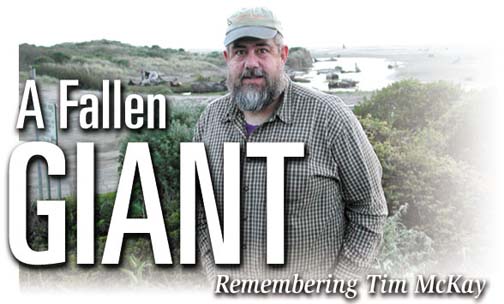
 The
Journal rarely changes its cover story based on breaking
news. (Breaking news is the job of the dailies.) This week was
an exception.
The
Journal rarely changes its cover story based on breaking
news. (Breaking news is the job of the dailies.) This week was
an exception.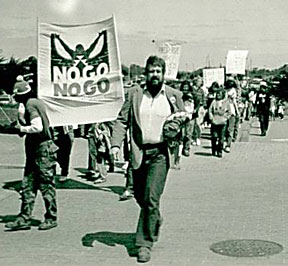 Tim
was absolutely ferocious when it came to the North Coast. For
[Offshore Oil] Lease Sale 53 he let it all hang out. A friend
who was working as a maid in a Eureka hotel cleaned a room Rep.
Doug Bosco had stayed in and found a copy of ECONEWS with
an article Tim had written underlined and annotated all over
the place by a clearly angry Congressman.
Tim
was absolutely ferocious when it came to the North Coast. For
[Offshore Oil] Lease Sale 53 he let it all hang out. A friend
who was working as a maid in a Eureka hotel cleaned a room Rep.
Doug Bosco had stayed in and found a copy of ECONEWS with
an article Tim had written underlined and annotated all over
the place by a clearly angry Congressman.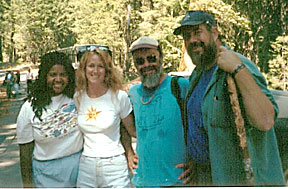 Tim
was up at the station to record ECONEWS Report, which
is the longest-running public affairs show on KHSU-FM. Tim would
show up at the station with a bag full of clippings and read
into the microphone all of the environmental news that affected
our area that he could fit into a half hour. For almost 20 years,
once a week North Coast residents could tune in to hear Tim's
deep melodic voice ranting on issues with the passion of an embedded
war reporter.
Tim
was up at the station to record ECONEWS Report, which
is the longest-running public affairs show on KHSU-FM. Tim would
show up at the station with a bag full of clippings and read
into the microphone all of the environmental news that affected
our area that he could fit into a half hour. For almost 20 years,
once a week North Coast residents could tune in to hear Tim's
deep melodic voice ranting on issues with the passion of an embedded
war reporter.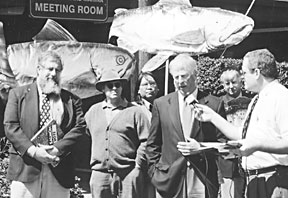 He
checked me out with a wary eye as we discussed a number of issues
— from the coastline to the health of the rivers to his
view on timber management on private and public lands. He was
well informed, had opinions and a breadth of knowledge that I
admired. We definitely connected on wildlife issues: habitat
protection for birds and waterfowl. Tim was well known for his
love of birding, his expertise as a bona fide Audubon member.
In fact, I think it was at a California Waterfowl Dinner that
Tim won the door prize — a very nice Remington 870 12-gauge
shotgun. Whenever we met after that, I always kidded him about
that shotgun: Did he take it birding or had he finally taken
up hunting?
He
checked me out with a wary eye as we discussed a number of issues
— from the coastline to the health of the rivers to his
view on timber management on private and public lands. He was
well informed, had opinions and a breadth of knowledge that I
admired. We definitely connected on wildlife issues: habitat
protection for birds and waterfowl. Tim was well known for his
love of birding, his expertise as a bona fide Audubon member.
In fact, I think it was at a California Waterfowl Dinner that
Tim won the door prize — a very nice Remington 870 12-gauge
shotgun. Whenever we met after that, I always kidded him about
that shotgun: Did he take it birding or had he finally taken
up hunting?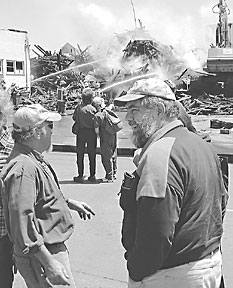 the
cause. "Persistence is victory," he would say, citing
the need for "endless pressure endlessly applied."
And he proved it, always showing up at meeting after meeting
and hearing after hearing, however remote, as well as in his
countless articles and radio programs.
the
cause. "Persistence is victory," he would say, citing
the need for "endless pressure endlessly applied."
And he proved it, always showing up at meeting after meeting
and hearing after hearing, however remote, as well as in his
countless articles and radio programs.